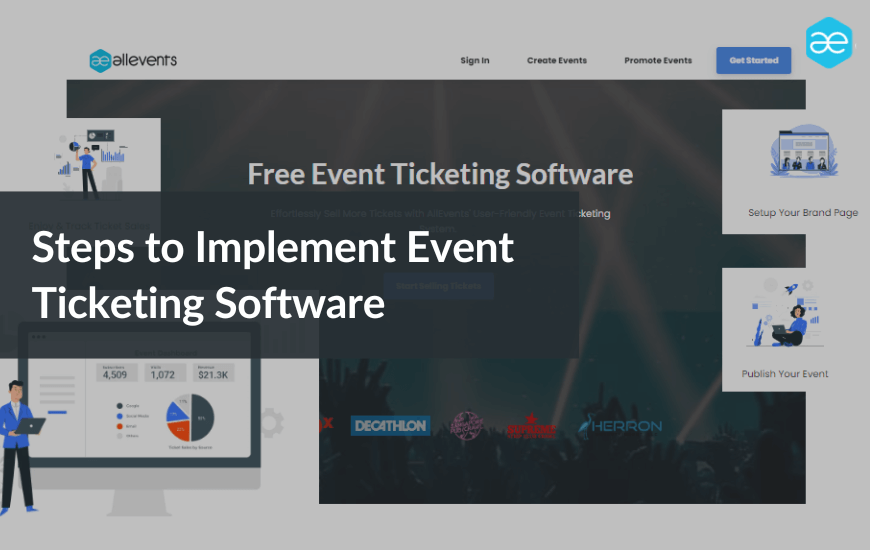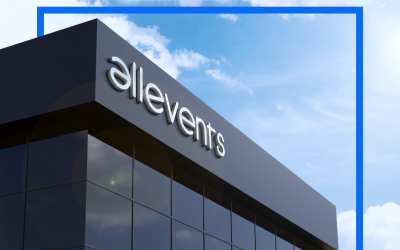A bustling event with eager attendees, and you are trying to manage ticket sales, the attendee check-in process, and seating arrangements.
Chaos ensues, frustrations rise, and the chances of a seamless ticketing-selling experience seem to dwindle.
You might say event ticketing software exists for seamlessly selling tickets online!
So, have you gone through the implementation process? Well, it can be an overwhelming process too!
This quick guide will take you through the steps to implement event ticketing software. Let’s unlock the world of convenience, efficiency, and happy attendees!
Implementing event ticketing software can enhance your event management process. Here is 9 step process to implement event ticketing software:
- Selecting the right event ticketing software
- Creating events on the platform
- Customize and configure
- Setting up payment processing
- Planning and implementation
- Migrating existing data
- Evaluation and optimization
- Providing ongoing support
- Evaluation and Optimization
1. Selecting the Right Event Ticketing Software
While choosing event ticketing software, consider factors such as user-friendliness, scalability, customer support, and integration capabilities.
Research a bit and narrow your options to select the event ticketing software that best matches your goals. Consider the software’s ticketing features, reporting capabilities, attendee management tools, and customization options. Check the user interface to ensure it is intuitive and easy to navigate.
Also, check for extra services or integrations that might enhance the ticketing process. Making the right software choice sets the stage for a seamless implementation.
Want a smooth and effortless ticketing experience? Join AllEvents and elevate your events by spending less and selling more.

2. Creating Events on the Platform
Once you have chosen the software, start creating events on the platform. Enter event-specific information such as name, date, time, location, and ticket categories.

Define ticket types, such as general admission, VIP, or an early bird, and set their prices and availability. Provide a clear and enticing event description to attract attendees.

The software should offer a user-friendly event creation interface. This will help you customize event pages to match your event branding.
3. Customize and Configure
Customize and configure the software according to your branding and event requirements. Personalize event pages, ticket designs, and registration forms to reflect your event branding.
Through customization and configuration, you can tailor the event ticketing software to showcase your brand and create a cohesive event experience.
4. Setting up payment processing
Set up secure payment processing options for hassle-free transactions for attendees. Use PayPal or Stripe to sell tickets and get instant and secure payments.
Integrate a secure payment processing system to enable smooth and hassle-free transactions. Select a payment gateway that supports various payment methods like credit cards, debit cards, and online wallets.
Ensure the software offers robust security measures to protect sensitive financial information. Streamlined payment processing increases attendee trust and minimizes potential hurdles during ticket purchase.
5. Planning implementation and deployment
Plan the implementation and deployment process carefully. Determine the timeline, allocate resources, and communicate with stakeholders for a successful rollout.
Identify key milestones, allocate resources, and set deadlines for each step. Assign responsibilities to team members involved in the implementation process.
A well-structured plan reduces implementation risks and ensures a successful launch.
6. Migrating Existing Data
Migrate existing data to the new software, including attendee information and ticket sales data. Ensure the accuracy and integrity of the transferred data.
Migrating our existing data to the event ticketing software lets us maintain continuity and view our event history.
If transitioning from a previous ticketing system, migrate existing data to avoid loss.
Confirm the accuracy of the migrated data and conduct thorough testing to ensure a seamless transition.
7. Launching, marketing and promoting
Once the software is set up, focus on launching, marketing, and promoting your event. Utilize the software’s built-in promotional tools. E.g. discount codes, referral programs, or social media integrations.

Use Email marketing, social media campaigns, and targeted advertisements to reach your target audience. Create engaging event content and encourage attendees. This will help to boost event attendance and ticket sales.
Want to promote your event but have like no time? Let out event marketing team help you!

8. Providing ongoing support
Provide ongoing support to organizers throughout the process. Address inquiries, resolve issues promptly, and gather feedback for continuous improvement.
Promptly address queries, troubleshoot technical issues, and guide users through the software’s features. A proactive and responsive support system builds trust and enhances the overall event experience.
9. Evaluation and Optimization
Check the performance of the event ticketing software and identify areas for optimization. Use data analytics to gather insights and make informed decisions for future events.
Periodically assess the software’s effectiveness by analyzing key performance indicators such as ticket sales, check-in efficiency, or attendee feedback.
Gain insights and make data-driven decisions by reporting and analytics features.
Following these steps, you can easily implement event ticketing software.
Now, let’s look at some common challenges you might face during this process.
Possible challenges while implementing Event Ticketing Software
Integration Issues: Integrating event ticketing software with existing systems. E.g. CRM or payment gateways can pose challenges.
- Data Migration: Importing data from previous ticketing systems to the new software can be complex. Regular backups and testing can minimize risks.
- User Adoption: Encouraging event staff and attendees to adapt to a new ticketing system can be challenging. Effective communication, training sessions, and user-friendly interfaces can help overcome resistance and promote user adoption.
- Cost Considerations: Implementing event ticketing software may involve upfront costs, licensing, or transaction fees. Carefully evaluate your budget and choose software options that align with your financial capabilities.
By being aware of these challenges, you can overcome hurdles. Here are the → Top 10 Event Ticketing Software reviews ← to help you choose one.
Good luck streamlining your event management workflow.
Conclusion
Implementing event ticketing software requires careful planning, research, and execution. You can streamline your implementation process by following these steps and utilizing the insights provided. Leave a lasting impression on attendees.
Embrace the power of event ticketing software to enhance ticket sales. Also, improve attendee experiences, and drive the success of your events.
Steps to Implement Event Ticekting Software FAQs:
What are the steps to implement a ticketing system?
Implementing a ticketing system includes:
1. Selecting the right software
2. Creating events on the platform
3. Customizing and configuring the software
4. Setting up payment processing
5. Planning implementation and deployment
6. Migrating existing data
7. Launching and promoting events
8. Providing ongoing support
9. Evaluating and optimizing performance.
Why you should implement a ticketing system?
Implementing a ticketing system simplifies event management, improves ticket sales efficiency, enhances attendee experiences, and provides data insights for better decision-making.
How do event ticketing systems work?
Event ticketing systems provide a platform for event organizers to create and manage events, set ticket prices and availability, handle ticket sales, generate tickets for attendees, and track attendee information. They also often offer features like seat selection, barcode scanning for check-in, and reporting capabilities.
What are some top event ticketing software?
Some popular event ticketing software options include AllEvents, Ticket Tailor, and Ticketleap.
Is a ticketing system and CRM different?
A ticketing system and CRM (Customer Relationship Management) are different. A ticketing system primarily focuses on managing ticket sales and event-related processes. In contrast, a CRM system is designed to manage customer relationships, track interactions, and store customer data across various touchpoints.
What are some challenges while implementing event ticketing software?
Common challenges when implementing event ticketing software include
1. Integration issues with existing systems
2. Data migration complexities,
3. Scalability concerns
4. Security considerations,
5. Cost factors
How to migrate data from one event ticketing software to another?
To migrate data from one event ticketing software to another, export your data in a compatible format (e.g., CSV), map the fields to the new software’s structure, and import the data. Verify its accuracy and communicate the transition to users for a seamless migration.
Does event ticketing software offer promotional plans?
Yes, many event ticketing software platforms, such as AllEvents, offer promotional plans. These plans often include features such as discount codes, promotional campaigns, special offers, and marketing integrations to help event organizers boost ticket sales and attract attendees.







